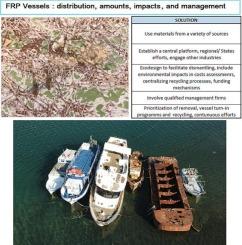海上纤维增强聚合物船舶报废与废弃的综合分析
IF 4.9
3区 环境科学与生态学
Q1 ENVIRONMENTAL SCIENCES
引用次数: 0
摘要
纤维增强聚合物(FRP),又称玻璃纤维,由于其高强度、轻量化和耐腐蚀的特性,是一种广泛应用于海洋、运输和建筑行业的复合材料。虽然frp在这些应用中是有利的,但frp的处置和回收,特别是在船上,仍然具有挑战性。2022年全球FRP市场价值为39亿美元。越来越多的玻璃钢容器正在达到其生命周期的终点,全球每年总计达到25万至50万吨,这加剧了环境问题。自20世纪50年代以来一直流行的玻璃钢船,由于回收方法有限,通常被丢弃在垃圾填埋场。废弃船只释放污染物并分解成微塑料,对航行、生态系统和人类健康构成危害。各国正在探索热解和回收等替代方案,尽管进展不一。为船只回收提供资金的扩大生产者责任(EPR)制度就是积极政策的一个例子。然而,需要更广泛的努力来改善回收基础设施和研究可持续材料。解决玻璃钢船对环境的影响需要合作研究、政策制定和创新的解决方案,如生态设计和改进的回收方法,特别是在全球对船只和玻璃钢材料的需求持续增长的情况下。本文章由计算机程序翻译,如有差异,请以英文原文为准。

A comprehensive analysis of the scrapping and abandonment of fiber-reinforced polymer vessels at sea
Fiber-reinforced polymer (FRP), also known as fiberglass, is a widely used composite material in marine, transportation, and construction industries because of its high strength, lightweight properties, and corrosion resistance. While FRPs are advantageous for these applications, the disposal and recycling of FRPs, especially in boats, remain challenging. The global FRP market valued at $3.9 billion USD in 2022. An increasing number of FRP vessels are reaching the end of their lifecycle, amounting to a global total of 250,000 to 500,000 tons of end-of-life vessels each year, contributing to environmental concerns. FRP boats, which have been popular since the 1950s, are often disposed of in landfills, as recycling methods are limited. Abandoned vessels pose hazards to navigation, ecosystems, and human health, releasing pollutants and breaking down into microplastics. Countries are exploring alternatives such as pyrolysis and recycling programs, although progress varies. An extended producer responsibility (EPR) system, which funds boat recycling, is an example of a proactive policy. However, broader efforts are needed to improve the recycling infrastructure and research sustainable materials. Addressing the environmental impact of FRP vessels requires collaborative research, policy development, and innovative solutions such as eco-design and improved recycling methods, especially as the global demand for boats and FRP materials continues to grow.
求助全文
通过发布文献求助,成功后即可免费获取论文全文。
去求助
来源期刊

Marine pollution bulletin
环境科学-海洋与淡水生物学
CiteScore
10.20
自引率
15.50%
发文量
1077
审稿时长
68 days
期刊介绍:
Marine Pollution Bulletin is concerned with the rational use of maritime and marine resources in estuaries, the seas and oceans, as well as with documenting marine pollution and introducing new forms of measurement and analysis. A wide range of topics are discussed as news, comment, reviews and research reports, not only on effluent disposal and pollution control, but also on the management, economic aspects and protection of the marine environment in general.
 求助内容:
求助内容: 应助结果提醒方式:
应助结果提醒方式:


